The Accademia Bridge in Venice on the Grand Canal
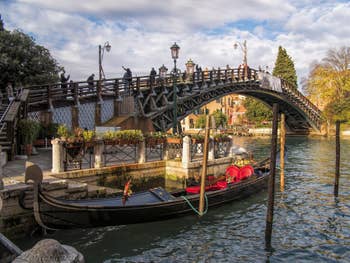
Gondola at the foot of the Accademia Bridge The Accademia Bridge owes its name simply to the Accademia Museum located at one of its ends.
It is also known as the Carità (Charity) Bridge, after the Campo de la Carità in front of the museum.
To be more precise, the Accademia museum is actually housed in the buildings that originally housed the Scuola de la Carità.
Until the mid-nineteenth century, the Grand Canal in Venice had only one bridge, the Rialto Bridge.
It was on the initiative of the Austrians, who were occupying Venice militarily at the time, that the first metal bridge was built over the Grand Canal, linking the Campo de San Vidal in the Sestier di San Marco with the Campo de la Carità in the Sestier di Dorsoduro.
This first metal bridge, which was opened to the public on 20 November 1854, was designed by an English engineer by the name of Alfred Neville and built in English workshops.
Two years after the Accademia Bridge another metal bridge was created over the Grand Canal, the one at the railway station.
In 1933, the metal Accademia Bridge was replaced by a wooden bridge, designed by the architect Eugenio Miozzi.
Note the record time it took to build this temporary wooden bridge: 37 days! Work began on 10 December 1932 and was completed on 15 January 1933.
The wooden bridge was intended to be temporary, the idea being to launch an architectural competition to build a bridge worthy of Venice on this site.
This architectural competition to build a bridge worthy of Venice was a success. This architectural competition to build a stone bridge did indeed take place and even had a winner, the architect Duilio Torres who was also the architect of the Pont del Ponte del'Arsenale and the Ponte dei Giardini. But there was no follow-up.
And so, as in so many cases, the temporary became definitive and it is still this "temporary" bridge of the Accademia that you can see today and, above all, use to cross from one bank to the other.
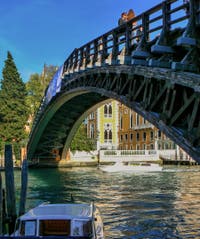
The Accademia Bridge A project for a glass bridge to replace the Accademia Bridge "provisional" was presented in 1985 at the Tsikuba Japanese Exhibition but the project remained unfinished.
The idea of a bridge in this part of Venice was not new, however, as a fifteenth-century chronicle mentions a bridge project that was to link the Campo de San Vital to the Campo de la Carità.
But this bridge project, presented for approval in 1488, like that of 1985, five centuries later, had also remained unfulfilled.
The Accademia Bridge over the Grand Canal in Venice has therefore, as a result of all this hesitation, from 1488 to the present day, remained a bridge... left behind.
And it's likely that this wooden bridge will remain "provisional" for a long time to come, since it underwent restoration in 1983-84. But after all, all the bridges in Venice were originally made of wood!
And yet its usefulness is indisputable. Just look at the fact that between 11 in the morning and midday, more than 1,500 people cross it (according to a 1998 study of Venice's bridges).
Venice's Accademia Bridge on the Grand Canal: A view like no other in the world
What makes the Accademia Bridge so charming is the magnificent view it affords of the Grand Canal and its Palazzi.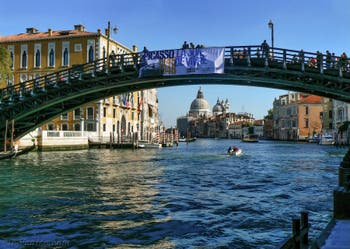
The Accademia Bridge The bridge's considerable height, made up of a single, fairly curved arch, offers a bird's-eye view of the nearest palaces, an angle not often enjoyed in Venice.
And there's no shortage of beautiful palaces on either side of the Accademia Bridge!
So you'll find that along with the Rialto Bridge it's certainly one of the bridges where you stop most at its summit to admire the view.
Another special feature is that it is made of wood.
And this is not without consequence for the effect it produces when you walk through it: it moves, it vibrates, it resonates, in short: it lives!
Its slightly old-fashioned character undoubtedly gives it a charm that has meant that to this day nobody has dared to replace this temporary relic.
In the meantime, it plays the sandwich man all year round, displaying banners featuring exhibitions right in the middle of its parapet.
And now it seems that those from the Palazzo Grassi are managing to squat on it permanently.
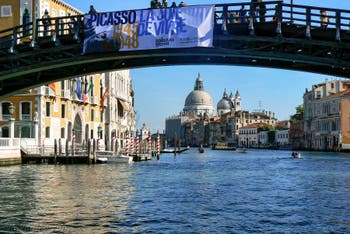
The Accademia Bridge The writer Paul Morand used to start his days in Venice on the Accademia Bridge.
He liked to sit at the little café on the left (coming from the Sestier di San Marco), just below the bridge.
It has to be said that this place is bathing in the morning sun and Paul Morand therefore usually went there around ten o'clock for this reason. As he said himself, at that time and in that place:
"The air has not yet served; it runs to you, all washed out, coming from the sea."
Paul Morand
Another French writer, who left us a very fine book on Venice, "Venise que j'aime", described the Accademia Bridge like this:
"This is the wooden bridge of the Accademia.
The crowd that climbs up and down it in an amusing clacking of heels is not quite the same as that of the Rialto."
André Fraigneau
This thought, from the 1950s is still true.
The Rialto Bridge, due to the presence of the nearby Erbaria and Pescheria markets, is still widely used by Venetians, while the Accademia Bridge, particularly from 9am onwards, is mainly used by... tourists.
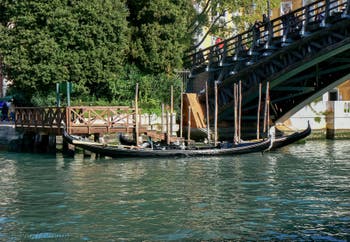
Gondolas at the foot of the Accademia Bridge But as we said above, we never tire of crossing the Accademia Bridge for its views, day or night!
This superb view, this landscape of water and palaces was also what charmed Henri de Régnier in his "Venetian Tales" when he passed by the Accademia Bridge :
"So I got up and set off and, via S. Fantin, S. Maurizio and the Campo Morosini, I reached the Ponte dell'Academia, which crosses the Grand Canal in its glorious perspective.
This view is familiar to me, of course, but it always excites my admiration and I never see the noble curve of this magnificent avenue of water again without being moved by its beauty.
This feeling was so strong that I found it difficult to continue on my way."
Henri de Régnier - Venetian Stories
Back to Top of Page

